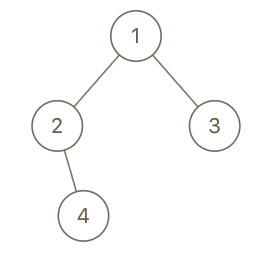C++
Java
Python
Python3
C
C#
JavaScript
Ruby
Swift
Go
Scala
Kotlin
Rust
PHP
TypeScript
Racket
Erlang
Elixir
Dart
monokai
ambiance
chaos
chrome
cloud9_day
cloud9_night
cloud9_night_low_color
clouds
clouds_midnight
cobalt
crimson_editor
dawn
dracula
dreamweaver
eclipse
github
github_dark
gob
gruvbox
gruvbox_dark_hard
gruvbox_light_hard
idle_fingers
iplastic
katzenmilch
kr_theme
kuroir
merbivore
merbivore_soft
mono_industrial
nord_dark
one_dark
pastel_on_dark
solarized_dark
solarized_light
sqlserver
terminal
textmate
tomorrow
tomorrow_night
tomorrow_night_blue
tomorrow_night_bright
tomorrow_night_eighties
twilight
vibrant_ink
xcode
上次编辑到这里,代码来自缓存 点击恢复默认模板
/**
* Definition for a binary tree node.
* struct TreeNode {
* int val;
* TreeNode *left;
* TreeNode *right;
* TreeNode() : val(0), left(nullptr), right(nullptr) {}
* TreeNode(int x) : val(x), left(nullptr), right(nullptr) {}
* TreeNode(int x, TreeNode *left, TreeNode *right) : val(x), left(left), right(right) {}
* };
*/
class Solution {
public:
bool isCousins(TreeNode* root, int x, int y) {
}
};
运行代码
提交
golang 解法, 执行用时: 0 ms, 内存消耗: 2.3 MB, 提交时间: 2024-02-08 10:11:17
/**
* Definition for a binary tree node.
* type TreeNode struct {
* Val int
* Left *TreeNode
* Right *TreeNode
* }
*/
func isCousins(root *TreeNode, x, y int) (ans bool) {
depth := 0
var father *TreeNode
var dfs func(*TreeNode, *TreeNode, int) bool
dfs = func(node, fa *TreeNode, d int) bool {
if node == nil {
return false
}
if node.Val == x || node.Val == y { // 找到 x 或 y
if depth > 0 { // 之前已找到 x y 其中一个
ans = depth == d && father != fa
return true // 表示 x 和 y 都找到
}
depth, father = d, fa // 之前没找到,记录信息
}
return dfs(node.Left, node, d+1) || dfs(node.Right, node, d+1)
}
dfs(root, nil, 1)
return
}
java 解法, 执行用时: 0 ms, 内存消耗: 40.4 MB, 提交时间: 2024-02-08 10:11:00
/**
* Definition for a binary tree node.
* public class TreeNode {
* int val;
* TreeNode left;
* TreeNode right;
* TreeNode() {}
* TreeNode(int val) { this.val = val; }
* TreeNode(int val, TreeNode left, TreeNode right) {
* this.val = val;
* this.left = left;
* this.right = right;
* }
* }
*/
class Solution {
private boolean ans;
private int depth;
private TreeNode father;
public boolean isCousins(TreeNode root, int x, int y) {
dfs(root, null, 1, x, y);
return ans;
}
private boolean dfs(TreeNode node, TreeNode fa, int d, int x, int y) {
if (node == null) {
return false;
}
if (node.val == x || node.val == y) { // 找到 x 或 y
if (depth > 0) { // 之前已找到 x y 其中一个
ans = depth == d && father != fa;
return true; // 表示 x 和 y 都找到
}
depth = d; // 之前没找到,记录信息
father = fa;
}
return dfs(node.left, node, d + 1, x, y) || dfs(node.right, node, d + 1, x, y);
}
}
cpp 解法, 执行用时: 0 ms, 内存消耗: 13.4 MB, 提交时间: 2024-02-08 10:10:43
/**
* Definition for a binary tree node.
* struct TreeNode {
* int val;
* TreeNode *left;
* TreeNode *right;
* TreeNode() : val(0), left(nullptr), right(nullptr) {}
* TreeNode(int x) : val(x), left(nullptr), right(nullptr) {}
* TreeNode(int x, TreeNode *left, TreeNode *right) : val(x), left(left), right(right) {}
* };
*/
class Solution {
public:
bool isCousins(TreeNode *root, int x, int y) {
bool ans = false;
int depth = 0;
TreeNode *father = nullptr;
function<bool(TreeNode*, TreeNode*, int)> dfs = [&](TreeNode *node, TreeNode *fa, int d) -> bool {
if (node == nullptr) {
return false;
}
if (node->val == x || node->val == y) { // 找到 x 或 y
if (depth) { // 之前已找到 x y 其中一个
ans = depth == d && father != fa;
return true; // 表示 x 和 y 都找到
}
depth = d; // 之前没找到,记录信息
father = fa;
}
return dfs(node->left, node, d + 1) || dfs(node->right, node, d + 1);
};
dfs(root, nullptr, 1);
return ans;
}
};
python3 解法, 执行用时: 44 ms, 内存消耗: 16.4 MB, 提交时间: 2024-02-08 10:10:29
# Definition for a binary tree node.
# class TreeNode:
# def __init__(self, val=0, left=None, right=None):
# self.val = val
# self.left = left
# self.right = right
class Solution:
def isCousins(self, root: Optional[TreeNode], x: int, y: int) -> bool:
ans = False
depth = father = None
def dfs(node: Optional[TreeNode], fa: Optional[TreeNode], d: int) -> bool:
if node is None:
return False
if node.val == x or node.val == y: # 找到 x 或 y
nonlocal ans, depth, father
if depth: # 之前找到 x y 其中一个
ans = depth == d and father != fa
return True # 表示 x 和 y 都找到
depth, father = d, fa # 之前没找到,记录信息
return dfs(node.left, node, d + 1) or dfs(node.right, node, d + 1)
dfs(root, None, 1)
return ans
python3 解法, 执行用时: 48 ms, 内存消耗: 14.9 MB, 提交时间: 2021-05-17 10:25:18
# Definition for a binary tree node.
# class TreeNode:
# def __init__(self, val=0, left=None, right=None):
# self.val = val
# self.left = left
# self.right = right
class Solution:
def isCousins(self, root: TreeNode, x: int, y: int) -> bool:
# x 的信息
x_parent, x_depth, x_found = None, None, False
# y 的信息
y_parent, y_depth, y_found = None, None, False
def dfs(node: TreeNode, depth: int, parent: TreeNode):
if not node:
return
nonlocal x_parent, y_parent, x_depth, y_depth, x_found, y_found
if node.val == x:
x_parent, x_depth, x_found = parent, depth, True
elif node.val == y:
y_parent, y_depth, y_found = parent, depth, True
# 如果两个节点都找到了,就可以提前退出遍历
# 即使不提前退出,对最坏情况下的时间复杂度也不会有影响
if x_found and y_found:
return
dfs(node.left, depth + 1, node)
if x_found and y_found:
return
dfs(node.right, depth + 1, node)
dfs(root, 0, None)
return x_depth == y_depth and x_parent != y_parent


